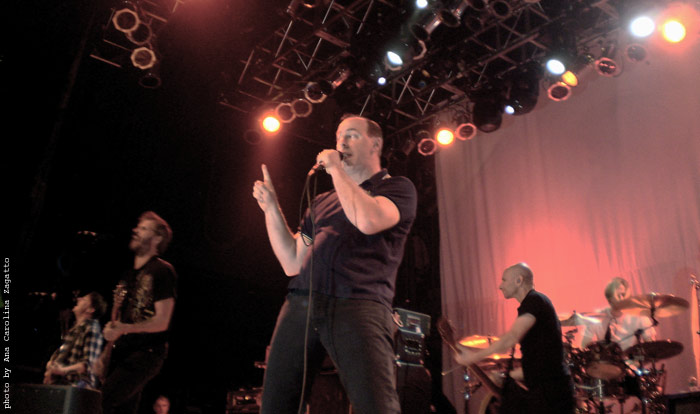
House of Blues, Cleveland, October 12
by Kevin J. Elliott
The last time I put on a Bad Religion record, I was clad in thrift-store flannel and Doc Martens. By the time “punk” had become a rite of passage for my generation, grunge was co-opting the lethargy and teenage rebellion born in classic punk. Of course, we listened to the classics, but the radio was playing Rancid, Green Day and the Offspring—proof that punk had finally become a marketable, watered-down commodity. Few of the traditionalists kept on in their original forms, but Bad Religion, arguably the bedrock of Southern California punk, survived throughout the ’90s, aside from their mimicking their (much younger) peers. Against the Grain and Generator were two albums that proved the band could hold their own with the old school and the buzz bin. For myself, I’ve always though that their 30-year existence is rooted in melodious three-part harmonies and ultra-brainy lyrics that still deliver Chomsky-esque questions of humanity.
Noticeably absent from Bad Religion’s 30th anniversary stop at Cleveland’s House of Blues was founding member and Epitaph CEO, Brett Gurewitz. His hardcore pop always offset singer Greg Graffin’s sharp wit. But former Minor Threat and Dag Nasty guitarist and longtime Bad Religion member Brian Baker, though looking the most weathered on stage, proved a permanent replacement with enough manic energy to drive the band through a setlist that was career encompassing. From “We’re Only Gonna Die,” off their 1982 debut, to the surprisingly thrilling and near-metal tracks from the recently released The Dissent of Man, the quintet remained spry and engaged without a hiccup. It brought about a realization that in my absence from (classic) punk, it had evolved once again. The crowd would have likely been the same were it new punk like crab-core sensations Attack Attack, old punk like Agnostic Front, or punk “other,” like Gwar (appearing at HOB the next night). The punk show, as high-cost entertainment, is a nostalgic event for all involved. Bad Religion is an apex for this ritual, a gathering where everyone sings the words with an understanding purpose, buys $30 t-shirts with their old logo, and chugs $10 beers (’cause they aren’t teenagers anymore) in a clean, safe, and sonically superior environment. Greg Graffin gave an exhausting performance as punk professor, and for this night, everyone’s punk pied-piper. The impression that all Bad Religion songs sound the same is warranted, but even among that seemingly one-dimensional grind hits like “21st Century Digital Boy” and “American Jesus” proved the band could always write an irresistible hook. This was, again surprisingly, not a display of old in the way, old cashing in, or old on a decline. It was punk as punk could be in a Fred Perry t-shirt.
Pop Montreal 2010
Leonard Cohen, Bird on a Wire and Songs from the Road
I Think We're Alone Now
Shellac and Helen Money and Hallogallo 2010 Live Reviews
Keep on Running: The Story of Island Records
Rush Live Review
Neil Hamburger, Hot February Night
Clinic Live Review
Devo Live Review
Rush, Beyond the Lighted Stage
Pitchfork Music Fest '10 Wrap-Up
Here Comes Your Weekend Parking Lot Blowout Live Review
Tristan Perich, 1-Bit Symphony
Touch and Go: The Complete Hardcore Punk Zine '79-'83
